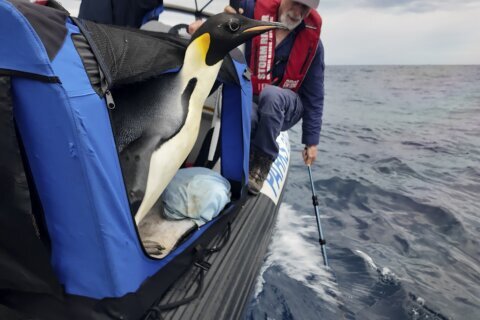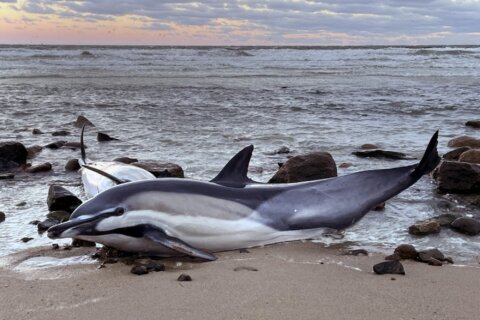CHURCHILL, Manitoba (AP) — When polar bears started coming to Churchill, tourists did too.
And then suddenly, polar bears began to appear everywhere — from artwork to cushion covers and even on beer cans — as residents of this remote Canadian town on Hudson Bay embraced their title as polar bear capital of the world.
Tourists are greeted with bear imagery wherever they go. At one hotel restaurant, a painting of three bears resting on the sea ice hangs high above dining tables. In a hotel room, a cushion features the animals spelling out “polar bear” as they strike various yoga-like poses. At a tour company gift shop, a giant blue sculpture of a bear welcomes customers outside the entrance.
But the bears are not just for tourists: one residential apartment building features a giant mural of a polar bear standing on its hind legs, peering into the town. Another mural, this one on the side of a business, features alternating images of polar bears painted in bright colors and beluga whales swimming in pairs. And readers at the town’s public library share their space with a giant sculpture of a grinning bear, displayed prominently between the shelves.
In the town’s grocery stores, too, shoppers can enjoy a “bluebeary” ale, with an illustration of a polar bear on the can.
Climate change, caused mostly by people burning coal, oil and gas, means that one day the local population of polar bears could almost disappear.
But as long as there are bears in Churchill, residents and tourists alike will continue to appreciate and memorialize them.
__
Follow Joshua A. Bickel on X and Instagram.
___
The Associated Press’ climate and environmental coverage receives financial support from multiple private foundations. AP is solely responsible for all content. Find AP’s standards for working with philanthropies, a list of supporters and funded coverage areas at AP.org.
Copyright © 2024 The Associated Press. All rights reserved. This material may not be published, broadcast, written or redistributed.







